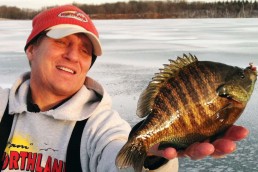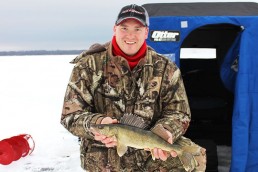On the Move for Winter ‘Gills
SHARE THIS POST
Last February, two fishing partners and I headed to a small local lake rumored to be the home to big bluegills. Without the aid of a lake map, we made an educated guess as to where the lake’s deep-water basin was and started to “grid search” the area.
Winter bluegills will roam a lake’s deep basin searching for insect life, which is prime winter forage.
This day, we spent a couple hours drilling holes, fishing and monitoring our sonar screens for fish. After searching for a couple hours, we hit “pay dirt,” finding numbers of bluegills, including big bulls around 10 inches long.
This day led to several more subsequent good outings. There were two keys to our successful search:
First, we were on a lake that has big fish. That may sound obvious, but finding big bluegills, at least in my part of Minnesota, has become more and more challenging. For that reason, we often find ourselves on smaller, lesser-known bodies of water chasing rumors that sometimes result in good catches, but sometimes don’t. Nevertheless, this strategy has paid dividends often enough that my partners and I always have an open ear to “that lake down the road” where someone catches big ‘gills off their dock from during spring.
Staying on the move searching various lakes is one aspect in finding big bluegills. The second key though, is staying on the move when searching one particular lake. As I said, we try to identify the deep-water basins and then set out working together to systematically search that area. We drill lots of holes and quickly work hole to hole looking for fish. We only fish a few minutes in a hole, as these fish will often reveal themselves quickly when present. Working as a team, drilling and cleaning holes and then hole-hopping, we can cover and eliminate unproductive water quickly.
Are you enjoying this post?
You can be among the first to get the latest info on where to go, what to use and how to use it!
Two pieces of equipment are vital to our bluegill search. The first is using tungsten jigs. Tungsten is denser than lead, so these are small jigs, yet they fish “heavy.” Heavy is important, as these tiny-profiled offerings (often the size preferred by big bluegills) can quickly plummet to the depths aiding in our quick-search method of getting a bait quickly to the depths, fishing for a few minutes, and then moving to the next hole if no fish are present.
Additionally, tungsten jigs don’t hang up as easily as lighter jigs in the slush at the top of a hole, so we don’t have to be as diligent in cleaning a hole, again important when we are moving hole to hole quickly looking for fish.
The other piece is a good portable fishing shelter that allows us to quickly move through an area hauling our gear, but also doubles as shelter from the elements. We use one-man shelters so we can split up in searching an area, and since midwinter temperatures can be downright brutal, it needs to be warm.
The cold of midwinter can be a bit of a downer, but this can still be a good time to catch big bluegills, especially for anglers willing to stay on the move searching for fish. Using some of these tips can help you get in on a good ‘gill bite yet this winter.
Mike Frisch is a western Minnesota fishing guide and co-host of the popular “Fishing the Midwest” television series. Learn more by visiting fishingthemidwest.com or following “Fishing the Midwest” on Facebook.
MWO
SHARE THIS POST
Did you enjoy this post?
You can be among the first to get the latest info on where to go, what to use and how to use it!
Mike Frisch
Mike Frisch is a lifelong angler who has been guiding anglers in western Minnesota for nearly three decades. Mike co-hosts the popular Fishing the Midwest television series and co-founded School of Fish, a leading fishing education program. Learn more by visiting fishingthemidwest.com or following “Fishing the Midwest” on Facebook.



